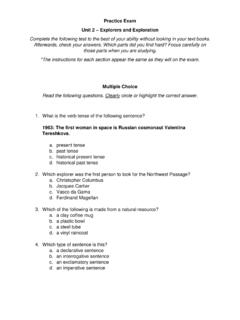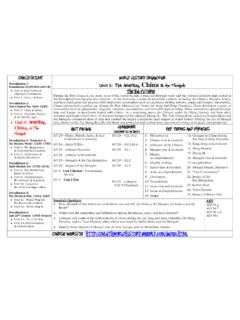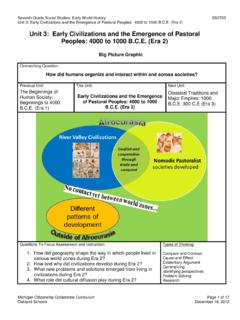Transcription of UNIT 3 : Global Interactions (1200-1650)
1 10-24-7 METHOD: HOW DO I KNOW YOU ARE STUDYING THESE NOTES? (EVIDENCE). WORLD HISTORY STUDY GUIDE. unit 3 : Global Interactions (1200-1650). In the years from 1200 through 1650, groups from various parts of the world came into contact with one another. In East Asia, cultural exchange occurred among China, Korea, and Japan. The Mongols established a vast empire that stretched from China westward into Europe. Over time, overland and sea trade routes linked more and more of the world and encouraged diffusion between the East and the West. In Europe, Global Interactions led to a new type of economy, based on money, and a new middle class. New ways of thinking emerged, in which old authority was questioned.
2 Nations began to take shape as individual rulers gained power. In Africa, commerce contributed to the rise of powerful trading empires and the spread of Islam. STANDARDS. Apply the four interconnected dimensions of historical thinking to the United States History Essential Standards in order to understand the creation and development of the United States over time. Concept(s): Historical Thinking, Creation, Development Human Legacy pages H6-H49. Analyze ancient civilizations and empires in terms of their development, growth and lasting impact. Concept(s): Civilizations, Achievement, Growth, Influence, Trade, Innovation, Class Human Legacy Chapter 1, 2, 3, 4, 5, & 6. Understand how conflict and innovation influenced political, religious, economic and social changes in medieval civilizations.
3 Concept(s): Power, Authority, Government, Innovation, Conflict Human Legacy Chapters 12,13, 14. Analyze the political, economic, social and cultural factors that lead to the development of the first age of Global interaction. Concept(s): Reform, Exploration, Improvement Human Legacy Chapters 15,16,17,19. Analyze exploration and expansion in terms of its motivations and impact. Concept(s): Exploration, Expansion, Colonization Human Legacy Chapters 16 and 18. CONSTRUCTIVE RESPONSE QUESTIONS. 1. Was the influence of wealthy families or increased trade more responsible for the Renaissance? 2. How did greed and corruption impact the influence of the Catholic Church? How did mercantilism affect indigenous/non-European populations?
4 3. Which of the following was the greatest motivation for European exploration; God, Gold, or Glory? 4. Why was the Middle Passage widely considered the most difficult leg of the Triangular Trade? 5. How did economic systems such as mercantilism, capitalism, joint-stock companies, and corporations, etc. influence exploration? HIGHLIGHT UNDERLINE - CIRCLE VOCABULARY CHUNKING *ASTERISKS / STARS* QUESTION MARKS??? NUMBER OF SENTENCES IN SUMMARY = NUMBER OF QUESTIONS IN NOTES. 1. 10-24-7 METHOD: HOW DO I KNOW YOU ARE STUDYING THESE NOTES? (EVIDENCE). STUDENT: _____ TEACHER:_____. ASSIGNMENT SHEET. DATE GRADE DATE PARENT. unit 3: Global Interactions ASSIGNED COMPLETED INITIALS. unit 3 Notes CLASS ASSIGNMENT.
5 HOMEWORK ASSIGNMENT. Section 1 Section 2 Section 3 Section 4 Section 5 TEST. Section 1 Quiz Section 2 Quiz Section 3 Quiz Section 4 Quiz Section 5 Quiz unit 3 POST-TEST. CONSTRUCTIVE RESPONSE QUESTIONS. OTHER ASSIGNMENTS. HIGHLIGHT UNDERLINE - CIRCLE VOCABULARY CHUNKING *ASTERISKS / STARS* QUESTION MARKS??? NUMBER OF SENTENCES IN SUMMARY = NUMBER OF QUESTIONS IN NOTES. 2. 10-24-7 METHOD: HOW DO I KNOW YOU ARE STUDYING THESE NOTES? (EVIDENCE). unit 3: Global Interactions (1200-1650). The BIG IDEA. SECTION1 U3: Early Japan and Feudalism Section overview Even though Japan was always an island nation, it was not completely isolated. It was influenced by Korea and China. Japan was ruled by an emperor since about 500, but fights between rival warlords led to the development of feudalism in the 1100s.
6 For several hundred years, military rulers controlled Japan. The dynasty that took power in 1603. brought stability and prosperity to Japan but imposed a rigid political and social order. 1. Geographic Setting Major Physical Features Japan is made up of a chain of mountainous islands in the Pacific Ocean off the coast of mainland Asia. There are four main islands and more than 3,000 smaller islands. The Japanese islands are part of the Ring of Fire, a group is islands around the Pacific Ocean that are vulnerable to earthquakes and volcanoes. Underground earthquakes can cause deadly tidal waves to sweep over the islands, destroying everything in their path. Impact on Japanese Life Because the islands of Japan are mountainous, the land is difficult to farm.
7 Most of the population has always lived in narrow river valleys or along the coast. The rugged terrain has sometimes acted as a barrier to political unity. The Japanese learned to use the sea both as a source of food and as a means of transportation from one island to another. The sea sometimes isolated Japan from other cultures, but it also acted as protection from invasion. In addition, the experience of living in an unsettled natural environment that could bring volcanoes, earthquakes, and tidal waves taught the Japanese a deep respect for the forces of nature. HIGHLIGHT UNDERLINE - CIRCLE VOCABULARY CHUNKING *ASTERISKS / STARS* QUESTION MARKS??? NUMBER OF SENTENCES IN SUMMARY = NUMBER OF QUESTIONS IN NOTES.
8 3. 10-24-7 METHOD: HOW DO I KNOW YOU ARE STUDYING THESE NOTES? (EVIDENCE). 2. SHINTOISM. Movement of Goods The traditional Japanese religion is called Shinto, meaning the way of the gods. Shinto is and People characterized by the worship of the kami, or divine spirits found in all living and nonliving The Japanese borrowed things. Kami are thought to control the powerful forces of nature. Believers respect the ideas selectively from kami and try to win their favor though prayer and offerings. The shared beliefs of the their mainland followers of Shinto eventually helped unite all of Japan. Shinto shrines still appear neighbors, Korea and throughout Japan in places of unusual natural beauty or interest.
9 China. Korea acted as a bridge between China 3. DIFFUSION FROM KOREA AND CHINA. and Japan. Japanese culture features a unique blend of its own original traditions and ideas borrowed from the nearby civilization of Korea and China. Korea often acted as a bridge between China and Japan. Contact between Korea and Japan occurred as a result of both warfare and trade. Koreans introduced the Japanese to various aspects of Chinese culture. Great interest in Chinese civilization was spared among the Japanese. Around 600, a Japanese ruler sent nobles to study in China. For over a century, during the Tang dynasty, the Japanese upper classes imported cultural traditions and ideas directly from China.
10 Between the 700s and the 1100s, the Japanese blended the best of China with their own traditions to produce a distinctly Japanese civilization. Chinese Influence on Writing Around 500, the Koreans brought the Chinese system of writing to the Japanese. By the 800s, however, when Tang China began to decline, the Japanese adapted the Chinese system of writing to suit their own language and ideas. Buddhism Koreans also brought Buddhism from China. The religion spread quickly, and it flourished alongside traditional Japanese religions During feudal times, a Chinese sect called Zen Buddhism spread throughout Japan. Zen Buddhists value peace, simple living, and beauty. Confucianism The Japanese also were influenced by the Chinese philosophy of Confucianism, especially its ideas about proper behavior and social order.








